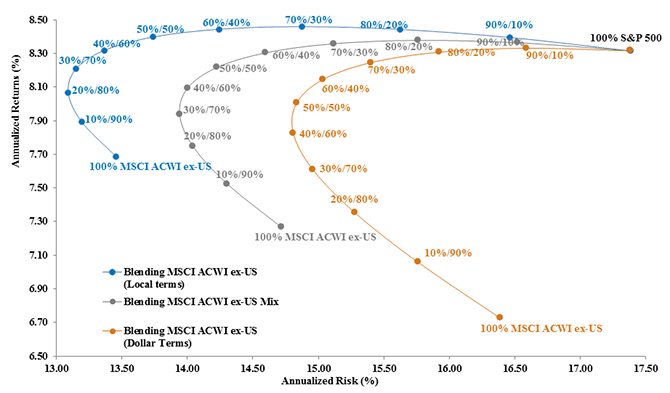How to Best Diversify from the S&P 500 Index



 • Lower Risk than the S&P 500 Index: Over the 10-year period shown, the S&P 500 Index had average annual volatility of about 17.4%. The MSCI ACWI ex-US Index (in U.S. dollars) had a 16.4% average annual volatility over the same period. Taking away the currency risk brought the average annual volatility down to 13.5%—almost 4% lower than that of the S&P 500 Index.
• Importance of the 50/50 Mix: We recognize that currencies tend to move in waves and that this 10-year period might be one in which foreign currency exposures faced a particular headwind. Therefore, an interesting baseline could involve looking at mixes of the MSCI ACWI ex-US Index that were 50% in local terms (i.e., without currency) and 50% in U.S. dollar terms (i.e., with currency). This would minimize the risk of being fully exposed or unexposed to fluctuating exchange rates, given that there is no way to know precisely how they might behave in the future.
• Lower Risk than the S&P 500 Index: Over the 10-year period shown, the S&P 500 Index had average annual volatility of about 17.4%. The MSCI ACWI ex-US Index (in U.S. dollars) had a 16.4% average annual volatility over the same period. Taking away the currency risk brought the average annual volatility down to 13.5%—almost 4% lower than that of the S&P 500 Index.
• Importance of the 50/50 Mix: We recognize that currencies tend to move in waves and that this 10-year period might be one in which foreign currency exposures faced a particular headwind. Therefore, an interesting baseline could involve looking at mixes of the MSCI ACWI ex-US Index that were 50% in local terms (i.e., without currency) and 50% in U.S. dollar terms (i.e., with currency). This would minimize the risk of being fully exposed or unexposed to fluctuating exchange rates, given that there is no way to know precisely how they might behave in the future.

Jeremy Schwartz has served as our Global Chief Investment Officer since November 2021 and leads WisdomTree’s investment strategy team in the construction of WisdomTree’s equity Indexes, quantitative active strategies and multi-asset Model Portfolios. Jeremy joined WisdomTree in May 2005 as a Senior Analyst, adding Deputy Director of Research to his responsibilities in February 2007. He served as Director of Research from October 2008 to October 2018 and as Global Head of Research from November 2018 to November 2021. Before joining WisdomTree, he was a head research assistant for Professor Jeremy Siegel and, in 2022, became his co-author on the sixth edition of the book Stocks for the Long Run. Jeremy is also co-author of the Financial Analysts Journal paper “What Happened to the Original Stocks in the S&P 500?” He received his B.S. in economics from The Wharton School of the University of Pennsylvania and hosts the Wharton Business Radio program Behind the Markets on SiriusXM 132. Jeremy is a member of the CFA Society of Philadelphia.

